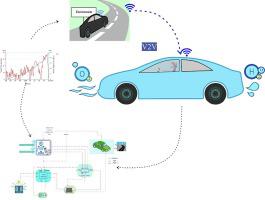当前位置:
X-MOL 学术
›
Energy Convers. Manag.
›
论文详情
Our official English website, www.x-mol.net, welcomes your feedback! (Note: you will need to create a separate account there.)
Improve performance and energy efficiency of plug-in fuel cell vehicles using connected cars with V2V communication
Energy Conversion and Management ( IF 10.4 ) Pub Date : 2024-03-13 , DOI: 10.1016/j.enconman.2024.118296 Amin Mesdaghi , Morteza Mollajafari
Energy Conversion and Management ( IF 10.4 ) Pub Date : 2024-03-13 , DOI: 10.1016/j.enconman.2024.118296 Amin Mesdaghi , Morteza Mollajafari

|
The proliferation of intelligent systems within the transportation sector has presented a favorable prospect for expediting the advancement of novel eco-friendly modes of transportation. Fuel cell vehicles offer a notable environmental benefit through reduced emissions. When combined with vehicle-to-vehicle (V2V) communication, a key driver in the realm of autonomous vehicles, they demonstrate potential for energy conservation. This study aims to investigate the performance of such vehicles. The performance of fuel cells (FCs) has been examined in relation to driving conditions. Research has demonstrated that as speed increases, the proportion of FC usage also increases. Additionally, plug-in vehicles exhibit a similar trend, contingent upon the utilization of an appropriate algorithm, in accordance with the driving conditions. The efficacy of navigation is compromised and the consumption of battery power is diminished. The study demonstrated that reduced stopping and acceleration instances during driving cycles result in decreased energy consumption for vehicles. Additionally, the V2V communication system revealed that traffic control parameters, specifically the safety time () between two cars, significantly affect vehicle performance and fuel consumption. In the FTP-72 cycle, an increase in led to an increase in the car's travel range and a decrease in battery usage. Conversely, in other driving cycles, an increase in resulted in decreased travel range and increased energy consumption.
中文翻译:

使用具有 V2V 通信的联网汽车提高插电式燃料电池汽车的性能和能源效率
交通领域智能系统的普及为加快新型环保交通方式的发展提供了良好的前景。燃料电池汽车通过减少排放提供显着的环境效益。当与自动驾驶汽车领域的关键驱动因素——车对车 (V2V) 通信相结合时,它们展现出了节能的潜力。本研究旨在调查此类车辆的性能。燃料电池(FC)的性能已根据驾驶条件进行了检验。研究表明,随着速度的提高,FC 使用的比例也会增加。此外,插电式车辆也表现出类似的趋势,这取决于根据驾驶条件使用适当的算法。导航的功效会受到影响,电池电量的消耗也会减少。研究表明,驾驶周期中减少停车和加速次数可以降低车辆的能耗。此外,V2V 通信系统显示,交通控制参数,特别是两辆车之间的安全时间 (),会显着影响车辆性能和燃油消耗。在 FTP-72 循环中,增加导致汽车行驶里程增加和电池使用量减少。相反,在其他驾驶循环中,增加会导致行驶里程减少和能源消耗增加。
更新日期:2024-03-13
中文翻译:

使用具有 V2V 通信的联网汽车提高插电式燃料电池汽车的性能和能源效率
交通领域智能系统的普及为加快新型环保交通方式的发展提供了良好的前景。燃料电池汽车通过减少排放提供显着的环境效益。当与自动驾驶汽车领域的关键驱动因素——车对车 (V2V) 通信相结合时,它们展现出了节能的潜力。本研究旨在调查此类车辆的性能。燃料电池(FC)的性能已根据驾驶条件进行了检验。研究表明,随着速度的提高,FC 使用的比例也会增加。此外,插电式车辆也表现出类似的趋势,这取决于根据驾驶条件使用适当的算法。导航的功效会受到影响,电池电量的消耗也会减少。研究表明,驾驶周期中减少停车和加速次数可以降低车辆的能耗。此外,V2V 通信系统显示,交通控制参数,特别是两辆车之间的安全时间 (),会显着影响车辆性能和燃油消耗。在 FTP-72 循环中,增加导致汽车行驶里程增加和电池使用量减少。相反,在其他驾驶循环中,增加会导致行驶里程减少和能源消耗增加。



























 京公网安备 11010802027423号
京公网安备 11010802027423号